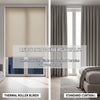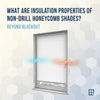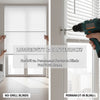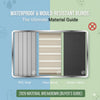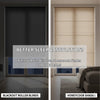Roman Blinds vs. Roller Blinds: A Style and Function Showdown
- by Mariam Labadze
Quick Answer
Roman blinds offer luxurious fabric elegance with soft horizontal folds suited to traditional and transitional interiors, costing £80-£200 per window whilst requiring more maintenance. Roller blinds provide sleek minimalism, easy operation, and practical durability at £40-£100 per window, excelling in contemporary spaces and moisture-prone rooms. Romans deliver superior aesthetics through textile warmth, acoustic dampening, and layered depth that rollers' flat profiles cannot replicate. However, rollers win on practicality—moisture resistance for bathrooms, effortless cleaning, compact stacking when raised, and lower costs. Choose Romans for living rooms, dining areas, and master bedrooms prioritizing visual impact. Select rollers for kitchens, bathrooms, home offices, and anywhere function trumps form. Budget-conscious whole-house projects favor rollers, whilst showcase rooms justify Roman investments.
Design Aesthetics and Visual Impact
Roman Blinds' Elegant Presence – Romans create sophisticated textile statements through fabric folds that introduce dimensional interest and luxurious warmth. The soft horizontal pleats when raised and smooth fabric expanses when lowered present textiles prominently, making material choices—patterns, textures, colors—central to overall room aesthetics.
This fabric emphasis suits interiors where textiles contribute significantly to design schemes. Romans coordinate beautifully with upholstered furniture, decorative cushions, and layered window treatments, creating cohesive soft-furnishing narratives that harder window treatments cannot support equally.
The substantial visual presence commands attention, making Romans ideal for feature windows or rooms where window treatments function as focal points rather than background elements. This prominence proves valuable in living rooms, dining areas, and master bedrooms where design impact justifies the investment and maintenance that Romans require.
Roller Blinds' Streamlined Simplicity – Rollers embrace minimalism through clean profiles that virtually disappear when raised, maximizing window transparency and architectural clarity. The flat fabric panels provide neutral backgrounds supporting broader design schemes without competing for attention or overwhelming spaces through excessive visual weight.
This restraint suits contemporary interiors valuing uncluttered aesthetics where every element serves clear purposes without decorative excess. Rollers integrate seamlessly into minimalist, Scandinavian, and industrial design schemes where ornamental window treatments would feel incongruous with overall philosophical approaches.
The simplicity proves particularly valuable in compact rooms where bulky treatments might overwhelm proportions. Rollers maintain visual spaciousness that Romans' more substantial presence potentially compromises in limited spaces.
Versatility Across Styles – Romans suit traditional, transitional, and even contemporary spaces when fabric selections align with overall aesthetics—linen textures for modern spaces, classic patterns for traditional rooms. However, their fundamental character remains decorative and soft.
Rollers adapt more universally across styles through fabric variety spanning sheer contemporary to traditional patterns, though their basic form remains decidedly modern. This flexibility makes rollers safe choices for diverse homes where single window treatment types must accommodate varying room aesthetics.
Functionality and Practical Performance
Operation Simplicity – Rollers win decisively on operational ease. Cordless spring mechanisms or motorized systems provide effortless raising and lowering with minimal effort. The straightforward operation makes daily adjustments genuinely convenient rather than mild inconveniences that discourage frequent use.
Romans typically use cord-and-pulley systems requiring more deliberate operation and greater effort, particularly for large windows. The operational resistance increases as fabrics age or accumulate dust in fold mechanisms, creating friction that makes adjustments progressively more laborious.
Space Efficiency – Rollers stack extremely compactly when raised—fabric winding onto tubes occupies minimal space above windows. This efficiency suits windows with limited header space or situations where maximizing glass visibility when treatments open proves important.
Romans stack less compactly due to horizontal fold accumulation. Large windows create substantial fabric bulk when raised, potentially obstructing upper portions of glass or creating visually heavy stacks that some find unattractive despite being functionally raised.
Light Control Precision – Both offer variable positioning, though rollers provide smoother incremental adjustment through infinite positioning along travel ranges. Romans position at fold intervals creating stepped rather than continuous adjustment, though quality mechanisms minimize this limitation's practical impact.
For precision light control in home offices or media rooms where specific illumination levels matter, rollers' smoother adjustment proves advantageous. For general residential use, Romans' fold-interval positioning proves perfectly adequate.
Maintenance Requirements – Rollers demand minimal maintenance—occasional dusting or damp wiping maintains appearances indefinitely. PVC variants particularly excel through complete moisture resistance and effortless cleaning that fabric alternatives cannot match.
Romans require more careful attention including regular vacuuming preventing dust accumulation in folds, careful spot-cleaning addressing marks, and occasional professional cleaning maintaining acceptable appearance. This maintenance intensity suits homeowners genuinely appreciating textile window treatments and willingly investing time in proper care.
Material Options and Suitability
Roller Blind Materials – PVC rollers provide ultimate moisture resistance for bathrooms and kitchens, maintaining appearances and function despite steam, splashes, and humidity that destroy fabric alternatives. This practical advantage makes rollers default choices for moisture-challenged spaces.
Fabric rollers span enormous variety from sheer voiles to complete blackout materials, textured weaves to smooth synthetics, neutral solids to bold patterns. This range addresses virtually any aesthetic or functional requirement through appropriate fabric selection.
Thermal-backed rollers combine standard profiles with energy-efficient backing materials, delivering insulation benefits that basic Romans without specialized linings cannot match. This functional enhancement proves valuable in poorly insulated homes or rooms with significant heating/cooling challenges.
Roman Blind Fabrics – Romans showcase fabrics beautifully through substantial yardage displayed prominently when lowered. This textile emphasis encourages quality fabric investments where superior materials deliver visual and tactile rewards that roller profiles don't highlight equivalently.
Lining options—standard, thermal, or blackout—enhance Romans functionally whilst maintaining elegant exterior appearances. The layered construction provides insulation and light control that single-layer rollers without specialized backing cannot achieve.
However, moisture sensitivity restricts Romans to dry locations. Bathroom steam or kitchen grease cause rapid deterioration, staining, and mold growth that make Romans completely inappropriate for these environments despite aesthetic appeal.
Room-Specific Recommendations – Rollers suit bathrooms, kitchens, home offices, children's rooms (easy operation), and any space prioritizing practicality over aesthetics. Their versatility makes them excellent whole-house solutions when budget constraints prevent mixed approaches.
Romans belong in living rooms, dining rooms, master bedrooms, and formal spaces where aesthetics matter tremendously and practical limitations prove acceptable. The investment and maintenance prove worthwhile where visual impact justifies both.
Cost Comparison and Value
Initial Investment – Roller blinds cost £40-£100 per standard window depending on size, fabric quality, and features. This accessibility makes comprehensive whole-house installation financially feasible for mainstream budgets without requiring substantial compromises.
Roman blinds typically cost £80-£200 per window reflecting more complex construction, greater fabric requirements, and specialized mechanisms. Premium fabrics, large windows, or custom features quickly escalate costs beyond roller ranges, making Romans significant investments requiring careful budget consideration.
Long-Term Economics – Quality rollers last 8-12 years with minimal maintenance costs, delivering excellent cost-per-year value. The durability and low upkeep create favorable long-term economics despite occasionally higher initial quality investments versus budget alternatives.
Romans' 7-10 year lifespans prove shorter whilst maintenance costs—professional cleaning every 2-3 years at £20-£40 per blind—add ongoing expenses. The total ownership costs often exceed rollers significantly, though visual benefits justify premiums for aesthetically-focused households.
Replacement Considerations – When tastes change or rooms require refreshing, replacing economical rollers proves less painful than discarding expensive Romans. This flexibility favors rollers for trend-conscious households updating interiors periodically versus those maintaining consistent long-term aesthetics.
Installation Complexity
Roller Installation – Straightforward bracket mounting and simple mechanisms make roller installation genuinely DIY-friendly for competent homeowners. The lightweight materials and uncomplicated systems prove forgiving of minor installation imperfections that Romans tolerate less gracefully.
Professional installation costs £30-£50 per window, though many households successfully self-install saving these expenses whilst gaining satisfaction from completed projects.
Roman Installation – More complex mechanisms and heavier fabric assemblies make Roman installation more challenging. Proper cord routing, precise bracket positioning, and ensuring smooth operation require greater care and experience than rollers demand.
Professional installation proves worthwhile for Romans—£40-£60 per window—ensuring proper function and appearance that DIY attempts might compromise despite best efforts. The investment protects expensive window treatments through correct installation preventing operational problems or premature wear.
Lifespan and Durability
Environmental Impact – Rollers withstand varied conditions admirably. PVC variants particularly excel in challenging moisture, temperature fluctuations, and direct sunlight that accelerate Romans' deterioration. This environmental tolerance makes rollers practical for any location within homes.
Romans prove more environmentally sensitive. Moisture causes mold and deterioration, direct sun fades fabrics rapidly, and temperature cycling stresses mechanisms more than simpler roller systems. This sensitivity restricts appropriate Roman placement whilst requiring environmental management that rollers tolerate without special consideration.
Wear Patterns – Rollers typically age gracefully, maintaining function until eventual mechanism failures necessitate replacement. The straightforward systems either work properly or fail definitively rather than gradually degrading through annoying partial functionality.
Romans show age through fabric fading, mechanism stiffening, and operational difficulties that develop progressively. The decline proves gradual enough that homeowners often tolerate suboptimal performance longer than they should, living with deteriorated functionality rather than addressing through timely replacement.
Making Your Decision
Assess Priorities – If aesthetics, traditional elegance, and textile richness matter tremendously whilst you're willing accepting maintenance requirements and higher costs, Romans deliver unmatched visual rewards justifying their demands.
If practicality, easy maintenance, moisture resistance, and economical whole-house coverage prove paramount, rollers provide superior solutions delivering reliable performance without fuss or excessive investment.
Room-by-Room Strategy – Many households benefit from strategic combinations—Romans in living rooms and master bedrooms where aesthetics justify investments, rollers in bathrooms, kitchens, bedrooms, and practical spaces prioritizing function. This targeted approach optimizes value by directing premium solutions toward highest-impact applications.
Lifestyle Considerations – Busy families with limited time for maintenance favor rollers' practicality. Design-focused households willing investing in proper care embrace Romans' aesthetic contributions. Honest self-assessment about realistic maintenance commitment prevents frustration when high-maintenance purchases don't receive attention they require.
At 1 Click Blinds, we offer both Roman and roller options ensuring finding perfect solutions for every room, budget, and priority. Our expertise helps UK homeowners navigating these choices confidently, selecting window treatments that genuinely enhance homes through appropriate balances of beauty, function, and value matching individual circumstances and preferences.

